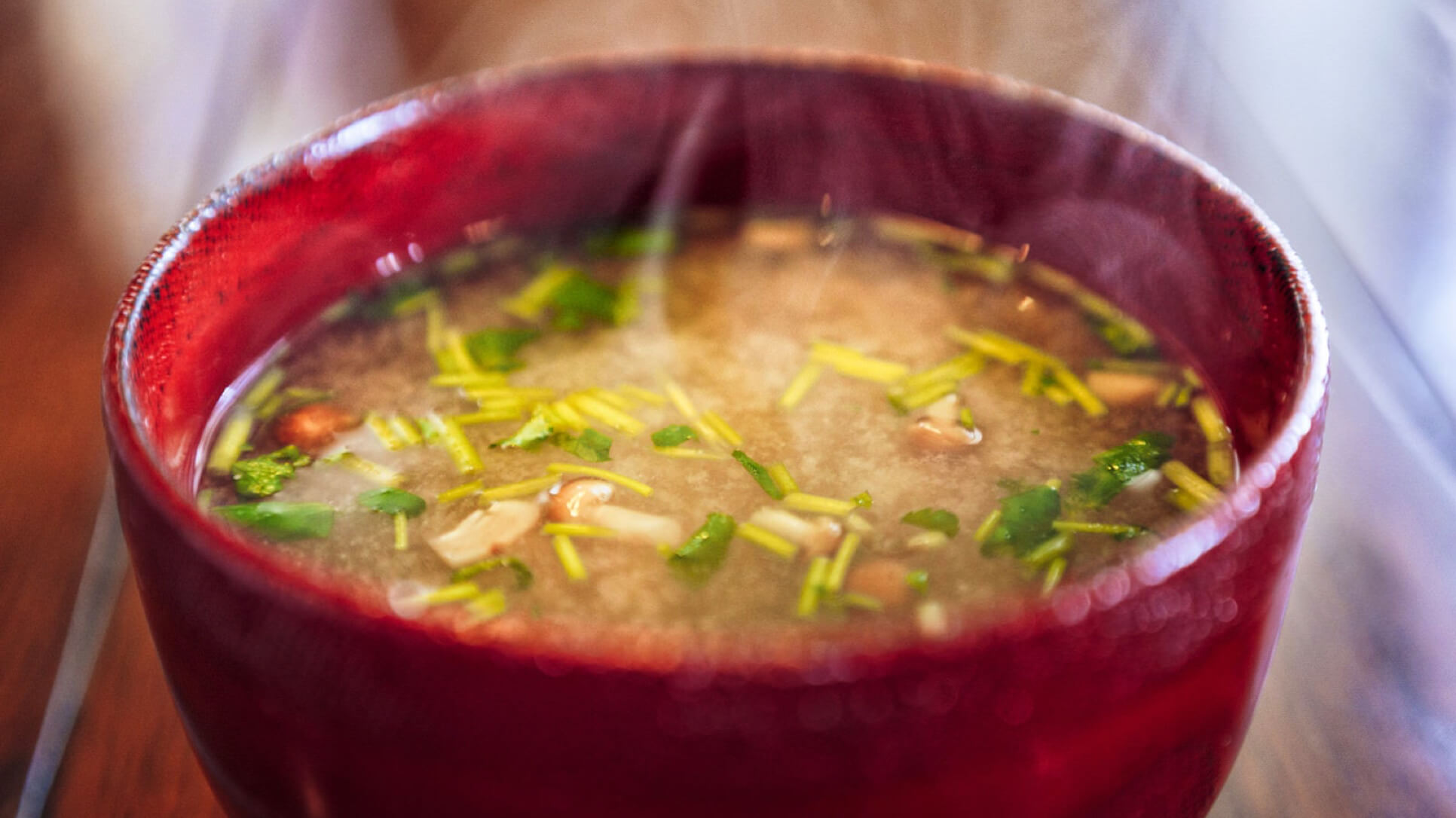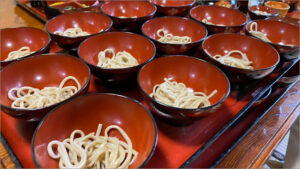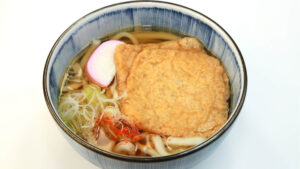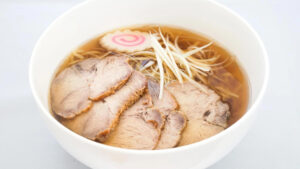Miso soup has long been a comforting staple on Japanese dining tables. Despite its simple ingredients, the umami-rich dashi and fragrant miso come together to gently warm both body and soul.
Its charm lies in its diversity—every household and region in Japan has its own favorite ingredients and preferred type of miso, giving each bowl a unique character.
In this article, we’ll introduce everything from the basics of miso soup to seasonal variations and regional specialties. Whether you’re a fan of Japanese cuisine or just curious to learn more, this guide will help you understand the heart of Japan’s most beloved soup. We hope you’ll enjoy it to the end.
Contents
- 1 What Is Miso Soup? A Staple of the Japanese Table
- 2 Types of Miso and Their Unique Characteristics
- 3 Classic to Creative: Ingredient Variations for Miso Soup
- 4 How to Make, Enhance, and Store Miso Soup
- 5 Miso Soup for Every Season and Region
- 6 Classic Miso Soup with Tofu and Wakame
- 7 Vegetable Miso Soup with Napa Cabbage and Carrot
- 8 Comforting Miso Soup with Sweet Potato and Spinach
- 9 Fragrant Miso Soup with Mushrooms and Leek
- 10 Rich Miso Soup with Eggplant and Fried Tofu
- 11 A Bowl That Reflects Japan’s Seasons and Culture — The Deep Appeal of Miso Soup
What Is Miso Soup? A Staple of the Japanese Table
Miso soup is one of the most beloved soup dishes in Japanese households. Despite being made with simple ingredients, the deep umami from the dashi and miso enhances the appetite and complements both main and side dishes. As a staple of breakfast and dinner, and often incorporating seasonal ingredients, miso soup is deeply woven into everyday Japanese life.
Its charm lies in the wide variety of miso types and ingredients, which differ from region to region—and even from family to family. Miso soup is more than just a dish; it carries cultural roots and personal memories. In this section, we’ll explore its history and cultural background.
The Origins and History of Miso Soup
Miso Culture in the Nara and Heian Periods
The roots of miso date back to ancient Japan. As early as the Nara period (8th century), fermented products known as “hishio” were already in use. Rather than being used purely as a seasoning, early miso was more like a preserved food, often eaten directly as a substitute for salt. By the Heian period, the aristocracy had begun incorporating miso into cooking—most notably in dishes like “miso-ni” (miso simmered foods)—marking the beginning of its role as a seasoning.
Miso Soup as a Staple for Samurai
During the Kamakura to Sengoku periods, miso became an essential part of a samurai’s portable diet. On the battlefield, dissolving miso in hot water and adding ingredients created a nourishing, quick-to-make soup—perfect for warriors in need of energy. This practical use contributed to the spread of miso soup, and as miso production scaled up, the dish gradually became popular among common people as well.
Miso Soup in Modern Japanese Homes
Today, miso soup remains a central element of the traditional Japanese meal structure known as “ichiju-sansai” (one soup, three dishes). The variety of ingredients and types of miso used varies greatly by region and household. It’s also incredibly convenient—many families make it using whatever ingredients they have on hand. While instant and ready-made versions are widely available, homemade miso soup continues to carry a special warmth and a sense of family tradition.
The “Ichiju-Issai” Tradition: Simplicity and Balance in Japanese Meals
“Ichiju-issai” (一汁一菜) refers to a traditional Japanese meal style consisting of rice, miso soup (the “one soup”), and one side dish. Though the modern ideal often expands to “ichiju-sansai” (one soup and three dishes), the foundation of daily Japanese meals is rooted in this simpler, balanced structure.
At the heart of this concept lies miso soup. By changing the ingredients, you can enjoy a wide range of flavors and nutrients while also reflecting the changing seasons. The following sections explore the important role miso soup plays in this deeply rooted culinary culture.
From a Nutritional Perspective
Miso soup allows you to consume a variety of nutrients in a single bowl. By combining ingredients such as vegetables, seaweed, tofu, mushrooms, and even seafood, you can achieve a well-rounded nutritional profile. For example, tofu provides plant-based protein, wakame seaweed offers minerals, and vegetables add vitamins and dietary fiber.
Miso itself is a fermented food believed to support gut health. While it does contain salt and should be consumed in moderation, miso soup as a whole is considered an excellent source of daily nourishment.
Miso Soup as a Staple of Japanese Breakfast
For generations, a warm bowl of miso soup has been an essential part of the Japanese breakfast. It’s quick to prepare, gently warms the body from the inside, and provides a comforting start to the day.
In colder months, the steam and aroma of freshly made miso soup can help awaken the senses and soothe both body and mind. Even just rice and miso soup can make for a satisfying meal, fitting perfectly with today’s fast-paced lifestyles that seek simplicity and comfort.
The Perfect Pairing with Traditional Japanese Cuisine
Miso soup complements classic Japanese dishes like grilled fish, simmered vegetables, and pickles. It enhances the flavor of each component while helping to balance heavier dishes with its light, umami-rich broth.
By adjusting the ingredients or type of miso used, the same bowl of miso soup can offer a new experience every time—making it a versatile and never-boring part of any meal. This flexibility, combined with harmony, is at the core of Japanese culinary philosophy.
Growing Popularity of Miso Soup Around the World
Miso soup is no longer limited to Japanese households—it’s gaining popularity across the globe. Driven by growing interest in healthy eating and the global boom in Japanese cuisine, miso soup has gradually found its way into everyday meals overseas. In urban restaurants and homes especially, this traditional dish is now appreciated as a “healthy and stylish” addition to the table.
Vegan and Vegetarian-Friendly Appeal
One of the reasons miso soup is attracting attention from vegans and vegetarians is that it can be deliciously prepared without using any animal products. Plant-based dashi made from kombu (kelp) or shiitake mushrooms offers a rich umami flavor, making the soup satisfying even without meat or fish.
When paired with ingredients like tofu, wakame seaweed, mushrooms, and vegetables, miso soup becomes a nutrient-rich bowl that provides protein, minerals, and dietary fiber—ideal for those following a plant-based diet.
A Japanese Superfood for Health-Conscious Eaters
Miso is a fermented food rich in probiotics that support gut health, and is increasingly being recognized as a “superfood from Japan.” While it’s true that miso contains salt, when consumed in moderation, it’s considered a body-friendly ingredient.
In addition, miso soup is low in calories, filling, and naturally gluten-free—making it popular among those pursuing wellness, clean eating, or weight management.
A Staple Menu Item at Japanese Restaurants Abroad
At Japanese restaurants outside of Japan, miso soup is nearly always featured alongside sushi, tempura, and other iconic dishes. Especially in cities across the U.S. and Europe, it’s commonly included as a staple in set meals and lunch combinations.
Instant miso soup has also become a popular export, allowing people to enjoy this comforting dish at home with ease. Now widely available at supermarkets and online stores, miso soup is becoming a familiar and accessible part of global dining culture.
Types of Miso and Their Unique Characteristics
The key factor that defines the flavor of miso soup is the miso itself. Japan boasts a wide variety of miso, and the type used can vary depending on the region or household. Differences in color, flavor, fermentation period, and ingredients all contribute to the unique taste of each miso type.
Shiro Miso (White Miso / Saikyo Miso)
Shiro miso, also known as Saikyo miso, is a light-colored miso made with a high proportion of rice koji and a short fermentation period. It is especially popular in Kyoto and other parts of the Kansai region. Known for its elegant sweetness and mild flavor, shiro miso is used not only in miso soup but also in dressings, marinades, and miso-pickled dishes.
Mild Sweetness and Creamy Flavor
Because of its short fermentation and relatively low salt content, shiro miso offers a very gentle flavor. The natural sweetness from the rice koji stands out, and it’s often described as “mellow” or “creamy” compared to other types of miso.
Its light and pleasant taste makes it popular with people of all ages, from children to the elderly. It’s also a perfect choice for breakfast or light meals, and pairs well with delicately flavored ingredients.
Popular Use in the Kansai Region
In Kyoto, Osaka, and other parts of the Kansai region, white miso has long been a household staple. It’s a key ingredient in traditional dishes such as New Year’s “white miso ozoni” soup and recipes featuring delicate ingredients like yuba (tofu skin), tofu, or turnips.
The refined and subtle taste of white miso perfectly complements the delicate flavors of Kyoto-style cuisine.
Recommended Ingredient Pairings
White miso pairs especially well with light and naturally sweet ingredients. Some great combinations include:
- Turnips and turnip greens
- Silken tofu
- Yuba (tofu skin) or aburaage (fried tofu)
- Spinach
- Sweet vegetables like carrots and sweet potatoes
Because white miso has its own natural sweetness, it’s best to use it with gentle broths like kombu dashi or lightly flavored bonito dashi to preserve its delicate taste.
Aka Miso (Red Miso and Hatcho Miso)
Aka miso, or red miso, is a dark, deeply flavored miso that has been aged for an extended period. Through long fermentation—typically one to three years—it develops a bold umami profile, a rich roasted aroma, and a deep, complex flavor. Notable varieties include Hatcho miso and mame (soybean) miso, both of which are especially popular in Japan’s Tokai region.
Because of its robust taste, red miso pairs exceptionally well with hearty ingredients such as meats and root vegetables, making it perfect for satisfying, full-bodied miso soups.
Rich Flavor and Deep Aroma
What sets red miso apart is its intense umami and layered aroma. Made primarily from soybeans and fermented over a long period, its color darkens and its taste deepens with time.
Miso soup made with red miso becomes more than just a side dish—it can feel like a main dish, rich and satisfying enough to accompany a bowl of plain rice on its own.
A Staple in Tokai Region Cuisine
Red miso is widely used in the Tokai region, which includes Aichi, Gifu, and Mie Prefectures. Hatcho miso from Aichi is especially well known and is essential in regional specialties such as miso nikomi udon (noodle stew) and dote-ni (miso simmered meat).
As a miso soup base, red miso is often combined with hearty ingredients like tofu, daikon radish, konjac, and pork—creating a rich and satisfying soup that is popular in everyday home cooking throughout the region.
Best Paired with Bold Ingredients
Due to its strong flavor, red miso is best paired with ingredients that can hold their own. Rather than delicate items, it’s complemented by more assertive ingredients such as:
- Pork or chicken
- Root vegetables like daikon, burdock root, and carrots
- Konjac or deep-fried tofu (aburaage)
- Grilled eggplant or grilled tofu
To bring out the full richness of red miso, ingredients should be simmered thoroughly so they absorb the flavor. The result is a soup that feels closer to a “miso stew” than a light broth.
Awase Miso and Regional Preferences Across Japan
Awase miso is a blended miso made by combining different types—most commonly white miso and red miso. With a well-balanced flavor and mild character, it’s a versatile option widely used in households across Japan.
While regional preferences for miso vary greatly, awase miso offers a harmonious middle ground, making it a popular and practical choice for many families.
The Perfect Balance of White and Red Miso
The biggest appeal of awase miso lies in its ability to deliver the gentle sweetness of white miso along with the robust depth of red miso. Rather than leaning heavily toward one taste, it offers both smoothness and complexity in a single spoonful.
Thanks to its balanced flavor, awase miso works well with nearly any ingredient and is suitable for a wide variety of dishes. It’s also an ideal option when cooking for people with different flavor preferences—truly a go-to “family miso.”
Regional Flavor Preferences in Japan
Miso preferences vary considerably by region in Japan. Here are some general trends:
- Kanto Region: Bold flavors are preferred, with red and awase miso being most common.
- Kansai Region: White miso remains deeply rooted in the food culture, with sweeter flavors being favored.
- Tohoku Region: Cold climate areas tend to prefer strong, salty red miso for its preservative qualities.
- Kyushu Region: Mugi miso (barley miso) and sweeter miso varieties are popular, known for their mild and mellow taste.
To accommodate this diversity, many commercially available miso products are formulated as awase miso blends, making them suitable across regions.
A Versatile Miso That’s Widely Available
Awase miso is widely used by major miso manufacturers and is easy to find in supermarkets and Japanese grocery stores abroad. Many households even create their own custom blends by mixing red and white miso to suit personal taste.
It’s also commonly used in instant miso soup and food service settings, making it an excellent choice for beginners unfamiliar with miso. If you’re unsure where to start, awase miso is always a safe and satisfying choice.
Classic to Creative: Ingredient Variations for Miso Soup
One of the greatest appeals of miso soup is the incredible flexibility of its ingredients. You can easily make it with whatever you have in your fridge, and you can also take advantage of seasonal vegetables and local specialties throughout the year.
Let’s begin with the most common ingredients found in everyday miso soups. These tried-and-true combinations are easy to make, well-balanced, and perfect for beginners and seasoned home cooks alike.
Essential Classic Ingredients
Classic miso soup ingredients are well-suited for anyone new to making miso soup or for those who enjoy it daily. These are familiar favorites used in both home cooking and traditional Japanese restaurants—reliable combinations that never disappoint.
Tofu and Wakame Seaweed
The most iconic pairing is tofu and wakame. The silky texture of soft tofu and the ocean aroma of wakame blend beautifully with the flavor of miso. This combination works well with any type of miso and is universally loved.
To avoid breaking the tofu, it’s best to add it after the miso has been dissolved. Garnishing with finely chopped green onions just before serving enhances the aroma and presentation.
Aburaage (Fried Tofu) and Leek
This savory duo combines the richness of aburaage and the fragrant sharpness of sliced leek. It’s a popular option known as a hearty “meal-style miso soup” that pairs well with rice.
For best results, quickly blanch the aburaage to remove excess oil, then slice it into thin strips. Diagonally slice the leek to maximize flavor. This combination works especially well with red or awase (blended) miso for a bold, satisfying soup.
Potatoes and Onions
Simple yet filling, potatoes and onions make a rustic and comforting miso soup. The fluffy texture of cooked potatoes and the natural sweetness of onions harmonize with the umami of the miso broth.
Because these ingredients take longer to cook, boil them in the dashi first before adding the miso. Use white or awase miso for a gentle and mellow flavor.
Vegetable-Packed Miso Soup
Miso soup is an excellent dish for boosting your vegetable intake with minimal effort. For today’s busy lifestyles, being able to get a variety of nutrients in a single bowl is a major benefit. By using seasonal vegetables, miso soup also becomes a gentle way to connect with the changing seasons—nourishing both body and soul.
Below, we introduce three categories of vegetables that provide balanced nutrition and visual appeal.
Root Vegetables (Daikon Radish & Carrot)
Daikon and carrots are classic root vegetables that add natural sweetness and texture to miso soup. When cooked thoroughly, they soften and absorb the umami of the broth.
- Daikon: Slice thinly or into half-moons and simmer a bit longer to let it soak up the dashi for a juicy finish.
- Carrot: Adds bright color and is rich in beta-carotene. Julienne it for quicker cooking—great for busy days.
These ingredients pair well with flavorful miso varieties like awase (blended) or red miso.
Leafy Greens (Spinach & Komatsuna)
Adding leafy greens not only enhances the visual appeal but also supplies essential vitamins and minerals—perfect for health-conscious eaters.
- Spinach: Parboil briefly before adding to remove bitterness and maintain a vivid green color.
- Komatsuna (Japanese mustard spinach): Holds its texture well and is ideal for soups thanks to its crisp bite.
These pair nicely with white miso or lighter awase miso to highlight the gentle flavors of the greens.
Mushrooms (Shimeji & Shiitake)
Mushrooms are rich in umami (especially guanylic acid), and when combined with dashi, they add a deep, savory complexity. They’re also low in calories and high in fiber, making them a great option for those watching their diet.
- Shimeji: Simply break into small clusters and add directly—easy and convenient.
- Shiitake: Slice thinly to release their aroma and create depth of flavor.
Cooking these mushrooms with awase or red miso enhances their rich, earthy taste.
Creative and Unusual Miso Soup Variations
While miso soup is widely known as a traditional Japanese dish, it’s surprisingly versatile and can be reinvented in many ways. Recently, unique “fusion-style” miso soups featuring Western ingredients and even dairy products have gained popularity. Here are three unexpected—but delicious—ideas for creative miso soup variations.
Add Soy Milk or Milk
Adding soy milk or regular milk to miso soup results in a creamy and mellow texture. Soy milk pairs especially well with miso, creating a healthy soup rich in plant-based protein.
- Soy Milk: Use unsweetened soy milk and add it after the miso to prevent curdling.
- Milk: Combine with white miso for a soup that tastes similar to a Western-style potage.
Recommended ingredients: potatoes, shimeji mushrooms, onions, and bacon.
With Beaten or Soft-Boiled Egg
Eggs enrich miso soup with protein and satisfaction. The soft texture of eggs blends perfectly with the umami of the miso and dashi broth.
- Beaten Egg: Slowly pour in a beaten egg after the miso has been added and stir gently for a fluffy finish.
- Soft-Boiled Egg: Top your soup with a poached or boiled egg for a visually appealing and hearty meal.
Pair with leafy greens like spinach or komatsuna for added color and nutrition.
Try Western Ingredients (Tomato & Cheese)
Though it may seem unconventional, Western ingredients like tomato and cheese actually pair well with miso soup. The umami of miso combined with the acidity and richness of these ingredients creates a surprisingly harmonious flavor.
- Tomato: Peel and dice before adding—simmer briefly to balance the acidity and sweetness with miso.
- Cheese: Add melting cheese at the end for extra richness and creaminess.
These variations are especially delicious with white or blended miso, and can be enjoyed as a Western-style soup alternative.
How to Make, Enhance, and Store Miso Soup
To make delicious miso soup, high-quality dashi (Japanese soup stock) is just as important as the ingredients and the miso itself. In this section, we’ll introduce both traditional and convenient ways to prepare dashi—from basic recipes to quick alternatives for busy days.
How to Make Basic Dashi
Dashi is the foundation of Japanese cuisine and supports the flavor and depth of miso soup. Mastering how to make dashi will not only improve your miso soup but also open up possibilities for other Japanese dishes.
Kombu Dashi (Kelp Broth)
Kombu dashi offers a gentle and mild umami flavor, making it perfect for white miso and vegetable-based soups. It’s also ideal for vegan and vegetarian diets.
How to make:
- Use 10g of kombu per 1 liter of water.
- Soak kombu in water for at least 30 minutes (preferably overnight).
- Heat slowly over medium heat and remove the kombu just before it boils.
Avoid boiling, as it can produce slimy textures and bitterness from the kombu.
Katsuobushi Dashi (Bonito Broth)
Katsuobushi dashi is known for its strong aroma and rich umami. It pairs well with red or blended miso and hearty ingredients like meat and root vegetables.
How to make:
- Bring 1 liter of water to a boil.
- Turn off the heat and add about 20g of bonito flakes.
- Let steep for 1–2 minutes, then strain through paper or a fine mesh sieve.
Use it as a first dashi, or boil again for a lighter second dashi.
Easy Dashi Using Instant Granules
Granulated instant dashi is a time-saving option perfect for beginners. Store-bought dashi (made from bonito, kombu, or dried sardines) helps create flavorful miso soup quickly and easily.
Tips:
- Use about 1 teaspoon of dashi granules per 400ml of water (check package instructions).
- Dissolve completely before adding miso.
- Adjust the amount of miso, as dashi granules often contain salt.
While convenient, be careful not to make the soup too salty. As you become more confident, try combining ingredients like kombu and bonito for your own custom dashi blend.
How to Dissolve Miso Properly (and Avoid Common Mistakes)
Surprisingly, one of the most common mistakes in making miso soup is related to how and when to dissolve the miso. If done incorrectly, the flavor may become harsh or the texture grainy. Here, we’ll walk you through the correct method to preserve both the taste and nutritional benefits of miso.
Why You Should Turn Off the Heat Before Adding Miso
The most important rule is to add miso after turning off the heat.
Miso is a fermented food, and its flavors and nutrients (such as enzymes) are sensitive to high heat. If added to boiling liquid, its aroma evaporates and the flavor becomes sharp or bitter. Overcooking can also dull the umami and introduce an unpleasant taste.
Tip: Once the broth and ingredients are fully cooked, turn off the heat and then dissolve the miso.
How to Use a Miso Strainer
Using a miso strainer ensures smooth, lump-free miso soup. It’s a favorite tool among professional chefs and very handy for home use.
How to use:
- Scoop some miso into the strainer.
- Pour a ladleful of hot broth into the strainer.
- Gently press and stir with chopsticks or a spoon until fully dissolved.
- Stir the soup lightly to distribute the miso evenly.
If you don’t have a miso strainer, use a ladle to hold the miso, add some broth, and stir with chopsticks until dissolved.
How to Adjust the Flavor
The amount of miso depends on the type and the ingredients. A general guide is 1 to 1.5 tablespoons of miso per 400ml of dashi. Use less for stronger miso like red miso, and more for milder types like white miso.
Tips for balance:
- Don’t add all the miso at once—start small and taste as you go.
- Consider the saltiness of your ingredients (e.g., fried tofu or bacon) when adjusting miso amount.
- For a flavor boost, try “tsuimiso”—adding a small amount of fresh miso at the end to finish.
Because miso soup is often enjoyed daily, even small adjustments can make a big difference. Once you’re comfortable, try experimenting with different miso types and ratios to discover your perfect flavor.
Tips for Meal Prepping and Freezing Miso Soup
For many, making fresh miso soup from scratch every day can be a challenge. That’s where meal prepping and freezing come in handy. With a few smart tricks, you can enjoy delicious miso soup even on your busiest days. However, to keep the taste and texture just right, it’s important to know which ingredients store well and how to handle them.
When to Add the Ingredients
The key to keeping pre-made miso soup tasty lies in two main points: how long the ingredients are cooked and when the miso is added.
For delicate ingredients like tofu and leafy greens: Add them just before eating. These can lose their texture or become watery if stored in the soup too long.
For hardy ingredients like daikon, carrots, and mushrooms: These can be cooked in advance and stored. They absorb flavor over time and often taste better after sitting in the broth.
You can add miso before storing the soup, but to preserve the best flavor and aroma, it’s better to store only the broth and cooked ingredients. Then, add the miso right before serving.
Which Ingredients Freeze Well and Which Don’t
Not all ingredients are suitable for freezing. Knowing what can and cannot be frozen helps maintain the quality and taste of your miso soup.
Ingredients That Freeze Well:
- Mushrooms (shimeji, enoki, shiitake)
- Daikon and carrots (thinly sliced for convenience)
- Aburaage (fried tofu pouch, best when frozen in portions)
- Beans and konnyaku (retain texture well)
Ingredients That Don’t Freeze Well:
- Tofu (becomes spongy and watery after thawing)
- Leafy greens (lose texture and become limp)
- Potatoes (turn grainy and mealy when thawed)
Freezing Tip: Freeze individual servings of miso soup in airtight containers or freezer bags. Consume within 2–3 weeks for best quality.
How to Reuse Leftover Miso Soup the Next Day
Leftover miso soup can be transformed into new dishes with just a few additions. These easy ideas let you enjoy the soup in different ways and avoid food waste.
- Make it into rice porridge: Add cooked rice and simmer lightly. Top with an egg for extra nutrition—a perfect breakfast or light meal.
- Add udon noodles for a hearty dish: Toss in leftover udon noodles and heat for a quick miso-style noodle stew.
- Change the flavor with curry or sesame: A sprinkle of curry powder or ground sesame can give the soup an entirely new twist.
These creative remakes help you get the most out of every bowl and explore new possibilities with miso soup.
Miso Soup for Every Season and Region
Miso soup can be enjoyed year-round, but using seasonal ingredients brings out richer flavors and better nutrition. With Japan’s distinct four seasons, miso soup becomes a delightful way to reflect seasonal changes on the dining table.
In this section, we introduce ideas for seasonal miso soups that highlight the best ingredients of each time of year.
Seasonal Miso Soup Ideas
Incorporating seasonal miso soups into your meals makes everyday dining more enjoyable and healthier. Here, we introduce representative miso soup ideas for spring, summer, and winter (autumn can be added separately).
Spring: New Potatoes & Rapeseed Blossoms (Nanohana)
Spring is a time of renewal. Tender and sweet spring vegetables come into season, making them perfect for light and aromatic miso soups.
- New potatoes: Light and fluffy with great flavor. Leaving the skin on adds both nutrients and texture.
- Nanohana (rapeseed blossoms): Slightly bitter, but pairs beautifully with white or blended miso for a gentle, elegant taste.
Spring miso soups are fragrant, colorful, and offer a refreshing way to welcome the new season.
Summer: Eggplant & Corn
In hot weather, refreshing flavors and moisture-rich summer vegetables take center stage.
- Eggplant: Thinly sliced with the skin on, eggplant becomes soft and silky when cooked. Great for chilled miso soups as well.
- Corn: Add fresh kernels for a burst of natural sweetness—especially popular with kids.
In summer, use lighter miso types like white miso or mugi miso (barley miso) to create a clean, refreshing finish.
Winter: Root Vegetables & Sake Lees (Sakekasu)
During the cold months, hearty miso soups filled with warming ingredients are especially valued.
- Root vegetables like burdock root (gobo), daikon radish, and carrots become sweeter the longer they are simmered, making them a perfect match for robust red miso.
- Sake lees (sakekasu): Adding a small amount enhances the depth of flavor and provides a warming effect from within. It’s also known to help boost the immune system and prevent colds.
Winter miso soup is rich and satisfying, often substantial enough to serve as a main dish in itself.
Regional Miso Soups Across Japan
While miso soup is a staple across the country, its ingredients, flavor profiles, and preparation methods vary by region—reflecting local food culture and climate. These unique regional miso soups, or gotochi misoshiru, are cherished as local soul food.
Here are three distinctive examples from north to south:
Kenojiru from Aomori
“Kenojiru” is a traditional miso-based soup from the Tsugaru region in Aomori Prefecture, typically enjoyed during winter and the New Year. The name is thought to derive from the words for “purification” and “vegetables,” reflecting its roots in Buddhist vegetarian cuisine.
- Features finely chopped root vegetables such as burdock root, carrot, and daikon, along with konnyaku, mountain vegetables, soybeans, and freeze-dried tofu.
- No oil is used—only miso and dashi broth for a light yet nourishing soup.
- Can be made in large batches and eaten over several days.
Simple yet rich in nutrients, kenojiru is a hearty soup filled with the wisdom of traditional rural life.
Noppe-jiru from Niigata
“Noppe-jiru” is a comforting miso (or soy sauce) soup from Niigata Prefecture, often served during holidays and family gatherings such as New Year celebrations and ceremonies. Its mild thickness and warmth make it a household favorite.
- Typically includes satoimo (taro), carrot, lotus root, shiitake mushrooms, and konnyaku.
- The soup is thickened with either potato starch or the natural starch from taro.
- Seasoning varies—some use miso, others prefer soy sauce, depending on the region or family recipe.
This soup is filling, warming, and packed with ingredients—perfect as a comforting, traditional home-style dish.
Butajiru from Kagoshima
In Kagoshima Prefecture, miso soup with pork is sometimes pronounced “butajiru” instead of the more common “tonjiru.” This hearty variation is rich in local character and often served as a main dish due to its satisfying volume and deep flavor.
- Common ingredients include pork, daikon, carrot, burdock root, konnyaku, and green onion.
- Typically uses robust miso varieties such as barley miso or blended miso for a deeper flavor.
- Pairs well with Kagoshima’s shochu culture and is popular in both homes and izakaya (Japanese pubs).
While pork miso soup is enjoyed across Japan, the choice of miso, ingredient cuts, and seasoning strength varies by region—making each local version unique.
Classic Miso Soup with Tofu and Wakame
Ingredients (Serves 2)
- Dashi stock: 400ml (kombu or bonito-based)
- Miso paste: 1 tbsp (white miso recommended)
- Silken tofu: 1/4 block (cut into cubes)
- Dried wakame: 1 tsp (rehydrated)
- Green onion: 1 stalk (sliced)
Instructions
- Pour the dashi stock into a pot and heat gently.
- Before it comes to a boil, reduce heat and dissolve in the miso paste.
- Add tofu and rehydrated wakame; warm gently for 2–3 minutes.
- Serve in bowls and top with sliced green onion. Enjoy!
Vegetable Miso Soup with Napa Cabbage and Carrot
Ingredients (Serves 2)
- Dashi stock: 400ml
- Miso paste: 1 tbsp (red or blended miso)
- Napa cabbage: 1 leaf (coarsely chopped)
- Carrot: 1/4 piece (thinly sliced)
- Sesame oil: 1 tsp (optional)
Instructions
- Heat sesame oil in a pot and lightly sauté the napa cabbage and carrot.
- Add the dashi stock and simmer for about 5 minutes.
- Lower the heat and dissolve in the miso paste.
- Once heated through, serve and enjoy!
Comforting Miso Soup with Sweet Potato and Spinach
Ingredients (Serves 2)
- Dashi stock: 400ml
- Miso paste: 1 tbsp (blended miso)
- Sweet potato: 1/3 piece (cut into half-moon slices)
- Spinach: 1 handful (lightly boiled and chopped)
Instructions
- Add the dashi and sweet potato to a pot and simmer until tender (about 7 minutes).
- Turn off the heat and dissolve in the miso paste.
- Add the spinach and warm it through with residual heat. Serve and enjoy!
Fragrant Miso Soup with Mushrooms and Leek
Ingredients (Serves 2)
- Dashi stock: 400ml
- Miso paste: 1 tbsp (white or blended miso)
- Mushrooms of your choice: 1/2 cup (e.g., shiitake, shimeji, enoki)
- Leek: 1/4 stalk (sliced diagonally)
Instructions
- Add the dashi, mushrooms, and leek to a pot and simmer for 3–4 minutes.
- Reduce the heat and gently dissolve in the miso paste.
- Once warmed through, ladle into bowls and serve hot.
Rich Miso Soup with Eggplant and Fried Tofu
Ingredients (Serves 2)
- Dashi stock: 400ml
- Miso paste: 1 tbsp (red miso recommended)
- Eggplant: 1/2 (cut into half-moons)
- Aburaage (fried tofu): 1/2 sheet (cut into strips)
Instructions
- Soak the eggplant in water to remove bitterness.
- In a pot, add the dashi, eggplant, and aburaage. Simmer over medium heat for about 5 minutes.
- Lower the heat and dissolve in the miso paste. Warm for another minute, then serve.
A Bowl That Reflects Japan’s Seasons and Culture — The Deep Appeal of Miso Soup
Miso soup is more than just a side dish; it is a comforting, everyday taste deeply rooted in the hearts of the Japanese people.
It reflects local traditions and the changing seasons, offering a “culinary landscape” unique to Japan.
With endless possibilities in miso types and ingredient combinations, miso soup can be enjoyed every day without growing tired of it.
By exploring the basic recipes, creative twists, and regional specialties introduced in this article, we hope you’ll be inspired
to bring your very own version of miso soup to your table.












